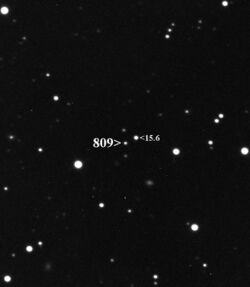Astronomy:809 Lundia
 Asteroid 809 Lundia (apparent magnitude 16.6) near a mag 15.6 star | |
| Discovery | |
|---|---|
| Discovered by | Max Wolf |
| Discovery date | 11 August 1915 |
| Designations | |
| (809) Lundia | |
| Pronunciation | /ˈlʌndiə/ |
| Named after | Lund Observatory |
| 1915 XP; 1936 VC | |
| Minor planet category | Main belt |
| Orbital characteristics[1] | |
| Epoch 31 July 2016 (JD 2457600.5) | |
| Uncertainty parameter 0 | |
| Observation arc | 100.48 yr (36700 d) |
| |{{{apsis}}}|helion}} | 2.72316 astronomical unit|AU (407.379 Gm) |
| |{{{apsis}}}|helion}} | 1.84193 AU (275.549 Gm) |
| 2.28254 AU (341.463 Gm) | |
| Eccentricity | 0.19304 |
| Orbital period | 3.45 yr (1259.6 d) |
| Mean anomaly | 76.7867° |
| Mean motion | 0° 17m 8.912s / day |
| Inclination | 7.14911° |
| Longitude of ascending node | 154.580° |
| 196.162° | |
| Physical characteristics | |
| Dimensions | 10.26 ± 0.07 km[2] |
| Mass | (9.27 ± 3.09) × 1014 kg[2] |
| Mean density | 1.64 ± 0.10 g/cm3[2] |
| Rotation period | 15.4142 h (0.64226 d) |
| V | |
| Absolute magnitude (H) | 12.2 |
809 Lundia is a small, binary, V-type asteroid[3] orbiting within the Flora family in the main belt. It is named after Lund Observatory, Sweden.
Characteristics
Lundia orbits within the Flora family. However, its V-type spectrum indicates that it is not genetically related to the Flora family, but rather is probably a fragment (two fragments, if its moon is included) ejected from the surface of 4 Vesta by a large impact in the past. Its orbit lies too far from Vesta for it to actually be a member of the Vesta family. It is not clear how it arrived at an orbit so far from Vesta, but other examples of V-type asteroids orbiting fairly far from their parent body are known. A mechanism of interplay between the Yarkovsky effect and nonlinear secular resonances (primarily involving Jupiter and Saturn) has been proposed.[4]
Binary system
Lightcurve observations in 2005 revealed that Lundia is a binary system of two similarly sized objects orbiting their common centre of gravity. "Lundia" now refers to one of the objects, the other being provisionally designated S/2005 (809) 1. The similarity of size between the two components is suspected because during mutual occultations the brightness drops by a similar amount independently of which component is hidden.[5] Due to the similar size of the primary and secondary the Minor Planet Center lists this as a binary companion.[6]
Assuming an albedo similar to 4 Vesta (around 0.4) suggests that the components are about 7 km across. They orbit each other in a period of 15.4 hours,[5] which roughly indicates that the separation between them is very close: to the order of 10–20 km if typical asteroid albedo and density values are assumed.
References
- ↑ "809 Lundia (1915 XP)". JPL Small-Body Database. NASA/Jet Propulsion Laboratory. https://ssd.jpl.nasa.gov/sbdb.cgi?sstr=809;cad=1.
- ↑ 2.0 2.1 2.2 Carry, B. (December 2012), "Density of asteroids", Planetary and Space Science 73: pp. 98–118, doi:10.1016/j.pss.2012.03.009, Bibcode: 2012P&SS...73...98C. See Table 1.
- ↑ M. Florczak; D. Lazarro; R. Duffard (2002). "Discovering New V-Type Asteroids in the Vicinity of 4 Vesta". Icarus 159: 178–182. doi:10.1006/icar.2002.6913. Bibcode: 2002Icar..159..178F.
- ↑ V. Carruba et al. (2005). "On the V-type asteroids outside the Vesta family". Astronomy & Astrophysics 441 (2): 819–829. doi:10.1051/0004-6361:20053355. Bibcode: 2005A&A...441..819C.
- ↑ 5.0 5.1 Poznań observatory "Physical studies of asteroids at Poznan Observatory". http://www.astro.amu.edu.pl/Science/Asteroids/. (Lightcurve showing signature of the binary)
- ↑ "Satellites and Companions of Minor Planets". IAU / Central Bureau for Astronomical Telegrams. http://www.cbat.eps.harvard.edu/minorsats.html.
External links
- Electronic Telegram No. 239 announcing the binary system (2005 October 1)
- Discovery Circumstances: Numbered Minor Planets (1)-(5000) – Minor Planet Center
- (809) Lundia, datasheet, johnstonsarchive.net
- Asteroids with Satellites, Robert Johnston, johnstonsarchive.net
- Lightcurve showing signature of the binary
- 809 Lundia at AstDyS-2, Asteroids—Dynamic Site
- 809 Lundia at the JPL Small-Body Database
 |

